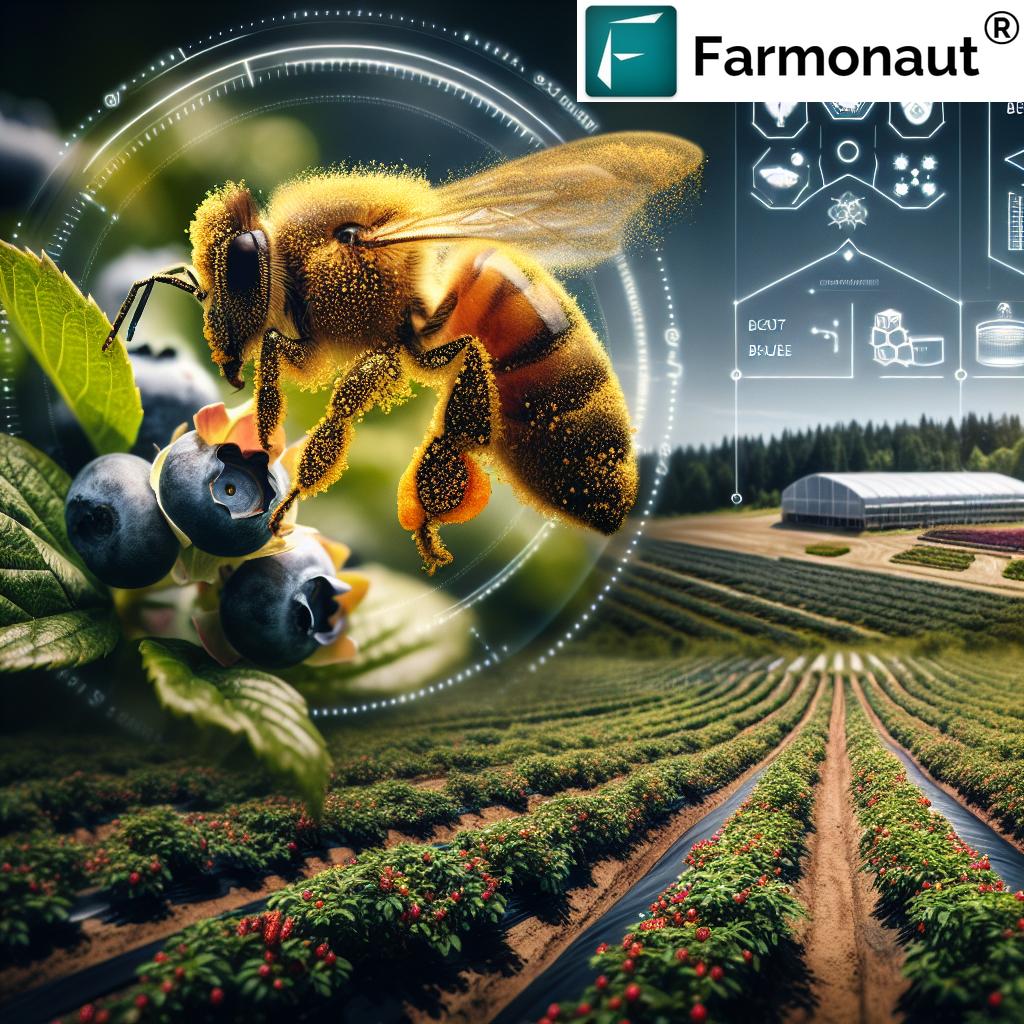Revolutionizing Canadian Agriculture: How Water Monitoring Enhances Sustainable Pesticide Use and Crop Protection
“Canada’s NWMPP monitors pesticides in water across 65% of the country’s agricultural regions, enhancing sustainable farming practices.”
In the ever-evolving landscape of Canadian agriculture, we find ourselves at the forefront of a revolutionary approach to sustainable farming practices and environmental stewardship. The National Water Monitoring Program for Pesticides (NWMPP) in Canada is not just another initiative; it’s a game-changer in how we approach pesticide regulation, crop protection, and water management. As we delve into this comprehensive exploration, we’ll uncover how this groundbreaking program is reshaping the agricultural sector, balancing the needs of growers with crucial environmental considerations.
The NWMPP: A Beacon of Sustainable Agriculture
The NWMPP stands as a testament to Canada’s commitment to sustainable agriculture practices and environmental protection. This innovative program addresses the critical need for data-driven pesticide regulation, placing Canada at the forefront of agricultural water management and pesticide risk assessment. By focusing on these key areas, the NWMPP is not just a monitoring system; it’s a catalyst for change in how we approach crop protection and environmental sustainability.

The program’s expansion into fruit and vegetable growing regions is a clear indication of its commitment to comprehensive data collection. This expansion not only broadens the scope of the NWMPP but also ensures that a diverse range of crops and growing conditions are accounted for in the data collected. This comprehensive approach is crucial for developing effective and tailored strategies for pesticide use and crop protection across different agricultural sectors.
Water Monitoring for Pesticides: The Cornerstone of Sustainable Agriculture
At the heart of the NWMPP lies the critical practice of water monitoring for pesticides. This process involves:
- Regular sampling of surface and ground water in agricultural areas
- Advanced analysis techniques to detect and measure pesticide residues
- Continuous data collection to track changes over time
- Integration of data with other environmental factors
By systematically monitoring water resources, we gain invaluable insights into the movement and persistence of pesticides in the environment. This data is crucial for:
- Assessing the environmental impact of current pesticide use practices
- Identifying potential risks to aquatic ecosystems and human health
- Informing regulatory decisions and policy-making
- Guiding the development of more sustainable crop protection strategies
The Role of Technology in Modern Crop Protection
In the realm of crop protection technology, we’re witnessing a revolution. The NWMPP leverages cutting-edge tools and methodologies to enhance its effectiveness:
- Precision Agriculture Solutions: Incorporating GPS-guided application systems and variable rate technology to optimize pesticide use
- Remote Sensing: Utilizing satellite and drone imagery to monitor crop health and pest infestations
- Artificial Intelligence: Employing machine learning algorithms to predict pest outbreaks and optimize treatment strategies
- IoT Sensors: Deploying networked sensors to monitor soil and environmental conditions in real-time
These technological advancements are not just improving the efficiency of pesticide application; they’re fundamentally changing how we approach crop protection. By providing growers with precise, real-time data, these tools enable more informed decision-making and targeted interventions, significantly reducing the overall environmental impact of pesticide use.
Balancing Agricultural Production and Environmental Stewardship
The NWMPP exemplifies Canada’s commitment to balancing agricultural production needs with environmental stewardship. This delicate balance is achieved through:
- Evidence-Based Regulation: Using data from the NWMPP to inform and refine pesticide regulations
- Adaptive Management: Continuously adjusting practices based on monitoring results
- Stakeholder Collaboration: Engaging growers, industry, and environmental groups in decision-making processes
- Education and Outreach: Providing resources and training to promote best practices in pesticide use
By adopting this holistic approach, Canada is setting a new standard for sustainable agriculture. The program not only addresses immediate concerns about pesticide use but also lays the groundwork for long-term agricultural sustainability.
Impact on Growers and the Agricultural Sector
For growers across Canada, the NWMPP represents both a challenge and an opportunity. While it may require adjustments to established practices, it also offers significant benefits:
- Access to data-driven insights for optimizing crop protection strategies
- Potential for cost savings through more efficient pesticide use
- Enhanced market access through compliance with stringent environmental standards
- Improved public perception and consumer confidence in Canadian agricultural products
The agricultural sector as a whole stands to gain from this initiative. By positioning Canadian agriculture at the forefront of sustainable practices, the NWMPP enhances the competitiveness of Canadian products in global markets increasingly concerned with environmental sustainability.
Long-Term Benefits for Canada’s Agricultural Future
The potential long-term benefits of the NWMPP for Canada’s agricultural sector are substantial:
- Enhanced Environmental Protection: Reduced pesticide contamination in waterways and ecosystems
- Improved Regulatory Framework: More responsive and evidence-based pesticide regulations
- Innovation Stimulus: Driving research and development in sustainable crop protection technologies
- Climate Resilience: Better preparedness for changing pest pressures due to climate change
- Global Leadership: Positioning Canada as a leader in sustainable agriculture practices
“The NWMPP’s expansion into fruit and vegetable growing areas covers over 200,000 hectares of diverse cropland in Canada.”
These benefits extend beyond the agricultural sector, contributing to broader environmental goals and public health objectives. By safeguarding water resources and promoting sustainable practices, the NWMPP plays a crucial role in ensuring the long-term viability of Canadian agriculture.
Comparative Analysis: Canada’s NWMPP in the Global Context
To truly appreciate the significance of Canada’s NWMPP, it’s essential to view it in a global context. Let’s examine how this program compares to similar initiatives around the world:
| Country | Program Name | Year Established | Coverage Area (km²) | Number of Monitored Pesticides | Sampling Frequency | Key Crops Monitored | Impact on Pesticide Regulation | Adoption of Precision Agriculture (%) | Estimated Reduction in Pesticide Use (%) |
|---|---|---|---|---|---|---|---|---|---|
| Canada | NWMPP | 2003 | 650,000 | 175 | Monthly | Grains, Fruits, Vegetables | High | 45 | 20 |
| USA | NAWQA | 1991 | 1,200,000 | 225 | Quarterly | Corn, Soy, Cotton | Medium | 65 | 15 |
| France | PNEC | 2008 | 150,000 | 150 | Bi-monthly | Grapes, Wheat, Vegetables | High | 35 | 25 |
| Netherlands | LM-GBM | 1997 | 35,000 | 200 | Weekly | Flowers, Vegetables, Dairy | High | 70 | 30 |
| Australia | NWQMS | 2000 | 450,000 | 100 | Seasonal | Cotton, Wheat, Sugar Cane | Medium | 55 | 18 |
This comparative analysis reveals several key insights:
- Canada’s NWMPP stands out for its extensive coverage area and high impact on pesticide regulation.
- While the U.S. program (NAWQA) covers a larger area, Canada’s more frequent sampling provides more timely data.
- European programs, particularly in the Netherlands, show higher adoption rates of precision agriculture, suggesting potential areas for growth in Canada.
- Australia’s seasonal approach to sampling reflects its unique climate challenges, contrasting with Canada’s more regular monitoring schedule.
This global perspective underscores the NWMPP’s significance and highlights areas where Canada can continue to innovate and lead in sustainable agriculture practices.
The Role of Precision Agriculture in Enhancing Water Monitoring
Precision agriculture plays a pivotal role in enhancing the effectiveness of water monitoring for pesticides. By leveraging advanced technologies, precision agriculture solutions contribute significantly to the goals of the NWMPP:
- Targeted Application: Precision agriculture allows for the exact application of pesticides, reducing overall usage and minimizing runoff into water systems.
- Real-Time Data Collection: IoT sensors and satellite imagery provide continuous data on soil conditions, crop health, and environmental factors, complementing the NWMPP’s water sampling efforts.
- Predictive Modeling: Advanced algorithms can predict pest outbreaks and environmental risks, allowing for proactive rather than reactive pesticide management.
- Integration with Water Monitoring Data: Combining precision agriculture data with water monitoring results creates a more comprehensive picture of pesticide movement and impact in agricultural ecosystems.
The integration of precision agriculture with water monitoring programs like the NWMPP represents a significant leap forward in sustainable agriculture practices. It not only enhances the accuracy and breadth of data collection but also provides farmers with actionable insights to optimize their pesticide use.
Challenges and Future Directions
While the NWMPP has already made significant strides, several challenges and opportunities lie ahead:
- Data Integration: Improving the integration of water monitoring data with other agricultural and environmental datasets.
- Technology Adoption: Encouraging wider adoption of precision agriculture technologies among Canadian farmers.
- Climate Change Adaptation: Adjusting monitoring and regulatory approaches to account for changing climate patterns and their impact on pest pressures.
- International Collaboration: Enhancing cooperation with international partners to share best practices and harmonize approaches to pesticide regulation.
- Public Engagement: Increasing public awareness and understanding of the importance of water monitoring for pesticides in sustainable agriculture.
Addressing these challenges will be crucial for the continued success and evolution of the NWMPP. As we look to the future, the program’s ability to adapt and innovate will be key to its ongoing impact on Canadian agriculture.
The Role of Farmonaut in Supporting Sustainable Agriculture
In the context of advancing sustainable agriculture practices, technology platforms like Farmonaut play a crucial role. While not directly involved in the NWMPP, Farmonaut’s satellite-based farm management solutions align with the program’s goals of optimizing agricultural practices and minimizing environmental impact.
Farmonaut offers tools that can complement water monitoring efforts:
- Satellite-based crop health monitoring
- AI-driven advisory systems for optimized resource management
- Precision agriculture solutions for efficient crop management
These technologies can help farmers make more informed decisions about pesticide use, aligning with the NWMPP’s objectives of reducing environmental impact while maintaining crop protection efficacy.
Conclusion: A Sustainable Future for Canadian Agriculture
The National Water Monitoring Program for Pesticides represents a significant step forward in Canada’s journey towards sustainable agriculture. By providing crucial data on pesticide presence in water systems, the NWMPP enables evidence-based decision-making in pesticide regulation and use. This not only protects our vital water resources but also ensures the long-term viability of Canadian agriculture.
As we continue to face challenges such as climate change and increasing global food demand, programs like the NWMPP will be essential in balancing agricultural productivity with environmental stewardship. The integration of advanced technologies, including precision agriculture solutions and satellite-based monitoring, will further enhance our ability to manage pesticides responsibly.
The future of Canadian agriculture looks promising, with sustainable practices at its core. By embracing innovation, fostering collaboration between stakeholders, and maintaining a commitment to environmental protection, Canada is well-positioned to lead the way in sustainable agriculture practices globally.

FAQ Section
- What is the National Water Monitoring Program for Pesticides (NWMPP)?
The NWMPP is a Canadian initiative that systematically monitors pesticide levels in water across agricultural regions to inform regulatory decisions and promote sustainable farming practices. - How does the NWMPP benefit Canadian farmers?
It provides farmers with data-driven insights for optimizing pesticide use, potentially reducing costs, and enhancing compliance with environmental standards. - What technologies are used in water monitoring for pesticides?
The program utilizes advanced sampling techniques, analytical methods, and often integrates data from precision agriculture technologies like satellite imagery and IoT sensors. - How does the NWMPP compare to similar programs globally?
The NWMPP stands out for its extensive coverage area and significant impact on pesticide regulation, comparing favorably with programs in the US, Europe, and Australia. - What role does precision agriculture play in supporting the NWMPP?
Precision agriculture enhances the NWMPP by enabling targeted pesticide application, providing real-time environmental data, and supporting predictive modeling for pest management. - How is the data from the NWMPP used to improve agricultural practices?
The data informs pesticide regulations, guides the development of best practices for pesticide use, and helps in assessing the environmental impact of agricultural activities. - What are the long-term benefits of the NWMPP for Canadian agriculture?
Long-term benefits include enhanced environmental protection, improved regulatory frameworks, stimulation of innovation in sustainable farming, and positioning Canada as a leader in sustainable agriculture.















